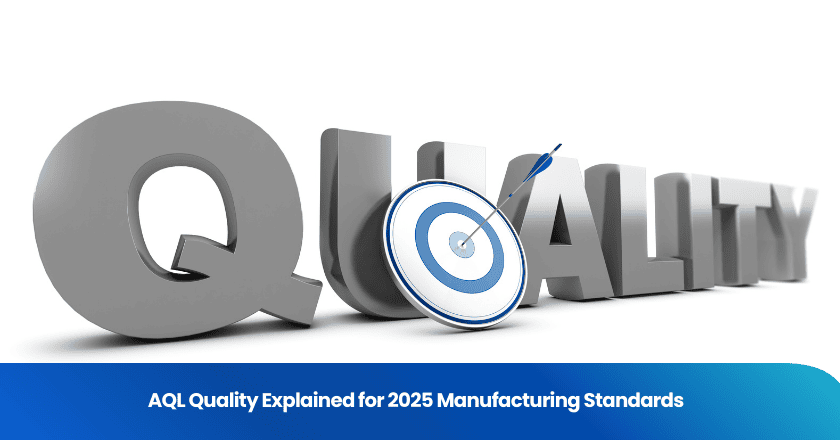
You encounter AQL every time you assess product batches for defects. AQL, or Acceptable Quality Level, sets the maximum number of defective items you can accept in a sample. This approach forms the backbone of quality control in modern manufacturing. As you adapt to 2025 manufacturing standards, understanding aql quality helps you ensure compliance and manage risk. AQL quality protects your production process and supports consistent results. When you apply aql, you build customer trust and safeguard your business reputation.
AQL in Quality Control
Definition of AQL
You encounter aql as a fundamental concept in quality control. It stands for Acceptable Quality Level. This term defines the maximum number of defective units you can accept in a sample before you reject the entire batch. You use aql to set clear expectations for product quality. When you apply aql, you create a measurable standard that guides your inspection process. This approach helps you make objective decisions about whether to accept or reject a lot.
Tip: You should always define your aql before starting any inspection. This step ensures consistency and transparency in your quality control procedures.
Aql gives you a practical way to balance cost and quality. You do not need to inspect every single item. Instead, you select a sample and use aql to determine if the batch meets your standards. This method saves time and resources while maintaining high levels of quality control.
Acceptance Quality Level
The acceptance quality level serves as the benchmark for your inspection process. You set this level based on the maximum percentage of defects you are willing to tolerate. For example, if your acceptance quality level is 1.5%, you will accept a batch if no more than 1.5% of the sample items are defective.
You can use the following table to understand how acceptance quality level works in practice:
| Sample Size | Acceptance Quality Level (%) | Maximum Defects Allowed |
|---|---|---|
| 80 | 1.0 | 1 |
| 200 | 1.5 | 3 |
| 500 | 2.5 | 12 |
You must choose your acceptance quality level carefully. If you set it too high, you risk letting too many defects pass through. If you set it too low, you may reject batches that are actually acceptable. You should always align your acceptance quality level with your product requirements and customer expectations.
Aql limits help you define the boundaries for your inspections. These limits ensure that your acceptance quality level remains consistent across different batches and production runs.
Acceptance Quality Limit
The acceptance quality limit represents the worst-case defect rate you are willing to accept in a batch. You use this limit to make final decisions during quality control inspections. If the number of defects in your sample exceeds the acceptance quality limit, you must reject the batch.
You should remember that the acceptance quality limit is not a target. It is the upper boundary of what you will tolerate. You aim for zero defects, but you recognize that some minor issues may occur. By setting a clear acceptance quality limit, you protect your business from unacceptable risks.
- You use aql limits to enforce strict quality control.
- You rely on the acceptance quality limit to maintain customer trust.
- You ensure that your products meet regulatory and industry standards.
Note: Consistently applying the acceptance quality limit helps you avoid costly recalls and damage to your reputation.
Aql, acceptance quality level, and acceptance quality limit work together to form a robust quality control system. You gain confidence in your production process, reduce risk, and deliver products that meet or exceed expectations.
Why AQL Quality Matters
Compliance for 2025
You face new regulatory demands in 2025. Authorities expect you to prove that your products meet strict standards. Aql quality gives you a clear method to show compliance. When you set aql levels, you create a record of your inspection process. This record helps you pass audits and avoid penalties. You can use aql charts to demonstrate that your products meet industry requirements. Regulators trust your process when you follow aql guidelines. You also protect your business from legal risks by using aql as part of your quality assurance system.
Note: Keeping detailed aql inspection records makes future audits easier and faster.
Risk Management
You reduce risk when you use aql in your inspections. Aql quality helps you catch defects before products reach your customers. You can spot trends in your production process by tracking aql results. If you see defect rates rising, you can act quickly to fix problems. This approach prevents costly recalls and protects your reputation. For example, if you find that a batch exceeds your aql limit, you can stop shipment and investigate the cause. You avoid sending faulty products to the market. This step keeps your business safe from financial loss and negative publicity.
- Use aql to identify weak points in your process.
- Respond to issues before they grow into bigger problems.
- Protect your company from unexpected costs.
Customer Satisfaction
You build trust with your customers when you apply aql quality. Customers expect reliable products. When you use aql, you show that you care about quality assurance. You can share your aql inspection results with clients to prove your commitment. Satisfied customers return for repeat business and recommend your products to others. For instance, if you deliver products that always meet your aql standards, your customers will notice the consistency. This reputation for quality sets you apart from competitors.
| Benefit | Impact on Business |
|---|---|
| Fewer defects | Higher customer loyalty |
| Consistent inspections | Stronger brand reputation |
| Transparent process | Increased trust |
Customers value your dedication to aql quality and reward you with their loyalty.
Applying AQL Standards
Sampling Methods
You start your inspection process by selecting the right sampling method. Sampling inspection allows you to evaluate a portion of your production batch instead of checking every item. This approach saves time and resources while maintaining control over quality. You choose a sample size based on the total quantity of products and the aql standards you want to meet.
You follow these steps for effective sampling inspection:
1.Determine the Lot Size
You count the total number of units in your batch. This number guides your sample size selection.
2.Set Your AQL Level
You decide the aql level setting that matches your product requirements. For example, you may select a 1.0% aql for critical components.
3.Select the Sample Size
You refer to the aql tables to find the recommended sample size for your lot. The practical guide to using aql tables helps you match your lot size with the correct sample quantity.
4.Randomly Select Items
You pick items from different parts of the batch to ensure fairness. This step prevents bias and gives you a true picture of quality.
Tip: Always document your sampling inspection process. Clear records support your compliance with aql standards.
Sampling inspection forms the foundation of apparel aql inspection and other industry-specific quality checks. You rely on this method to identify defective items before they reach your customers.
Defect Classification
You classify defects to make your inspection process more precise. Defect classification helps you decide which issues are acceptable and which require action. You group defective items into three main categories:
| Defect Type | Description | Example |
|---|---|---|
| Critical | Safety or regulatory risk | Sharp edges, contamination |
| Major | Affects function or appearance | Broken zipper, wrong color |
| Minor | Small, does not affect use | Loose thread, slight stain |
You set acceptance criteria for each defect type. You may allow a small number of minor defects but reject batches with critical issues. You use aql guideline to define the maximum number of defective items for each category.
You apply defect classification in apparel aql inspection to ensure garments meet customer expectations. You record each defect type during your inspection and compare results to your aql levels. This process helps you maintain consistent quality and comply with aql standards.
AQL Chart Use
You use aql charts to interpret your inspection results. These charts show you the maximum number of defective items allowed for your chosen sample size and aql level setting. You follow a step-by-step process to use aql charts effectively:
1.Find Your Lot Size
You locate your batch size on the chart.
2.Select Your AQL Level
You choose the aql level that matches your product requirements.
3.Read the Sample Size
You see how many items you need to inspect.
4.Check the Acceptance Number
You find the maximum number of defective items you can accept. If your sample has more defects than this number, you reject the batch.
Note: Using aql charts ensures you follow aql standards and make objective decisions during inspections.
You apply this process in every inspection, whether you work with electronics, textiles, or other products. You rely on aql charts to guide your acceptance criteria and maintain compliance with industry regulations.
You gain confidence in your quality control when you use aql charts and tables. You reduce risk, improve customer satisfaction, and support your business reputation.
1.Example:
2.You inspect a batch of 500 units with an aql level setting of 2.5%.
3.The aql chart shows a sample size of 80 and a maximum number of defective items allowed is 5.
4.If you find 6 defective items, you reject the batch.
You follow aql standards to ensure every inspection meets the requirements for 2025 manufacturing. You use aql guideline, defect classification, and sampling inspection to build a robust quality control system.
Best Practices and Pitfalls
Common Challenges
You may face several challenges when applying aql in your inspection process. One frequent issue involves misunderstanding the correct sample size. If you select the wrong sample, your results may not reflect the true quality of the batch. Another challenge comes from inconsistent defect classification. You might label defects differently from one inspection to another, which can lead to confusion. Sometimes, you may overlook the importance of random sampling. This mistake can introduce bias and reduce the effectiveness of your aql checks.
Tip: Always review your aql procedures before each inspection to avoid these common pitfalls.
Implementation Tips
You can strengthen your aql process by following a few best practices. First, train your inspection team on the latest aql standards. Clear training ensures everyone uses the same criteria. Next, use aql charts and tables during every inspection. These tools help you make objective decisions. Document each step of your inspection process. Good records support your quality assurance efforts and make audits easier. You should also schedule regular reviews of your aql procedures. This habit helps you catch errors early and improve your system over time.
Best Practices Table
| Practice | Benefit |
|---|---|
| Team training | Consistent inspections |
| Use of aql charts | Accurate acceptance decisions |
| Detailed documentation | Stronger quality assurance |
| Regular process reviews | Continuous improvement |
Avoiding Mistakes
You can avoid mistakes in aql application by staying alert to frequent errors. Never skip steps in your inspection process. Always use random sampling to get a true picture of your batch. Double-check your defect classifications to ensure accuracy. If you find a batch that exceeds your aql limit, take immediate action. Do not release products that fail to meet your standards. By following these steps, you protect your business and maintain high levels of quality assurance.
Remember, a strong aql process leads to better products and greater customer trust.
You gain real advantages when you use aql in modern manufacturing. Aql helps you control quality, reduce risk, and meet strict standards. Updated aql practices for 2025 keep your inspections effective and your products reliable. You should review your current aql process and look for ways to improve it. Start by training your team on aql, updating your inspection plans, and using aql charts in every batch review. Aql gives you the tools to build trust and deliver consistent results.
FAQ
What does AQL stand for in quality control?
AQL stands for Acceptable Quality Level. You use it to set the maximum number of defects allowed in a sample before rejecting a batch. This standard helps you maintain consistent product quality.
How do you choose the right AQL level?
You select your AQL level based on product requirements and customer expectations. Lower AQL values mean stricter quality control. Always review industry standards and discuss with your team before setting the level.
Can you use AQL for all types of products?
You can apply AQL to most manufactured products, including electronics, textiles, and consumer goods. You should adjust your sampling plan and defect classification to fit your specific industry and product type.
What happens if a batch fails the AQL inspection?
If your batch fails the AQL inspection, you must reject it. You should investigate the cause, correct the issue, and consider re-inspection. This process helps you prevent defective products from reaching your customers.
Why is random sampling important in AQL inspections?
Random sampling ensures you get an accurate picture of your batch quality. You avoid bias and increase the reliability of your inspection results. Always select samples from different parts of the batch.
Grow your business with TradeAider Service
Click the button below to directly enter the TradeAider Service System. The simple steps from booking and payment to receiving reports are easy to operate.



